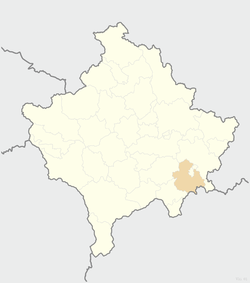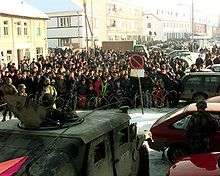Vitina
| Vitina Витина/Vitina (Serbian) Vitia or Vitisë (Albanian) | |
|---|---|
| Town and municipality | |
|
| |
 Location of the municipality of Vitina within Kosovo | |
| Coordinates: 42°18′N 21°23′E / 42.300°N 21.383°E | |
| Country | Kosovo[lower-alpha 1] |
| District | District of Gjilan |
| Government | |
| • Mayor | Sokol Haliti |
| • Municipal | 270 km2 (100 sq mi) |
| Elevation | 499 m (1,637 ft) |
| Population (2011) | |
| • Urban | 4,924 |
| • Municipal | 46,987 |
| • Municipal density | 170/km2 (450/sq mi) |
| Time zone | UTC+1 (CET) |
| • Summer (DST) | UTC+2 (CEST) |
| Postal code | 61000 |
| Area code(s) | +381 280 |
| Car plates | 06 |
| Website |
kk |
Vitina (Serbian Cyrillic: Витина) or Vitia (Albanian: Vitisë) is a town and municipality located in the Gjilan District of Kosovo[lower-alpha 1]. According to the 2011 census, the town of Vitina has 4,924 inhabitants, while the municipality has 46,987 inhabitants.
Municipality
- Ballancë/Balance
- Begunce
- Binça/Binač
- Budrikë e Epërme/Gornja Budrika
- Buzovik
- Çifllak/Čiflak
- Debelldeh/Debelde
- Devajë/Devaja
- Drobesh/Drobeš
- Gërmovë/Grmovo
- Gjylekar/Đelekare
- Goden i Madh/Veliki Goden
- Gushicë/Gušica
- Kabash/Kabaš
- Letnicë/Letnica
- Lubishtë/Ljubište
- Mjak/Mijak
- Novosellë/Novo Selo
- Podgorc/Podgorce
- Pozharan/Požaranje
- Radivojc/Radivojce
- Ramjan/Donje Ramnjane
- Ramnishtë/Ravnište
- Remnik/Ribnik
- Sadovinë e Çerkezëve/Čerkez Sadovina
- Sadovinë e Jerlive/Jerli Sadovina
- Shasharë/Šašare
- Sllatinë e Epërme/Gornja Slatina
- Sllatinë e Poshtme/Donja Slatina
- Smirë/Smira
- Stubëll e Epërme/Gornja Stubla
- Stubëll e Poshtme/Donja Stubla
- Tërpezë/Trpeza
- Tërstenik/Trstenik
- Vërban/Vrban
- Vërnakollë/Vrnavokolo
- Vërnez/Vrnez
- Zhiti/Žitinje
History

Ottoman period
The municipality has several settlements historically inhabited by the Laramans, crypto-Catholics.
Kosovo War and aftermath
Following the 1999 Kosovo War, it was the home of A Company, 2/505 Parachute Infantry Regiment, 82nd Airborne Division, the first KFOR troops to begin stabilization efforts in the municipality. After the initial unit left, Vitina was the site of a subsequent international scandal when a Staff Sgt. Frank J. Ronghi, from A company, 3/504 Parachute Infantry Regiment raped and killed a local girl. The subsequent investigation uncovered serious training and leadership deficiencies in the 3/504 Parachute Infantry Regiment, and catalysed a tremendous change in the training of units deploying for peacekeeping operations.[1] The Church of the Holy Mother of God, Podgorce was looted during the conflict.
During the NATO bombing of Yugoslavia, the Orthodox cemetery in Vitina and the village of Dobreš were hit by missiles.[2]
In August 2003, explosive devices planted in Klokot destroyed five Serb houses, with several injuries, including two American KFOR soldiers.[3]
Serbian Orthodox cemeteries have been destroyed in Vitina, among other towns, and in 2004 during unrest, nuns of the Binča monastery were physically attacked, by ethnic Albanians.[4]
Contemporary
In 2013 in response to a KLA monument being removed by Serbian authorities in Preševo, a Kosovo Albanian crowd in Vitina demolished a Yugoslav-era memorial for anti-fascist Partisans that were killed during the Second World War.[5] Members of the Kosovo Police were present but did nothing to intervene. The incident was filmed and posted to YouTube.[6]
Demographics
| Historical population | ||
|---|---|---|
| Year | Pop. | ±% p.a. |
| 1961 | 33,642 | — |
| 1971 | 39,780 | +1.69% |
| 1981 | 47,839 | +1.86% |
| 1991 | 57,290 | +1.82% |
| 2011 | 46,987 | −0.99% |
According to the last official census done in 2011, the municipality of Vitina has 46,987 inhabitants.
Ethnic groups
The ethnic composition of the municipality:
| Ethnic Composition, Including IDPs | |||||||||||||
| Year/Population | Albanian | % | Serbs | % | Croats | % | Roma | % | Total | ||||
|---|---|---|---|---|---|---|---|---|---|---|---|---|---|
| 1961 | 20,496 | 60.92 | 10,442 | 31.04 | 2,077 | 6.17 | 21 | 33,642 | |||||
| 1971 | 26,927 | 67.69 | 9,649 | 24.26 | 2,613 | 6.57 | 126 | 0.32 | 39,780 | ||||
| 1981 | 35,105 | 73.38 | 8,369 | 17.49 | 3,722 | 7.78 | 229 | 0.49 | 47,839 | ||||
| 1991 | 45,078 | 78.68 | 7,002 | 12.22 | 4,331 | 7.56 | 373 | 0.65 | 57,290 | ||||
| 2011 | 46 669 | 99,3 | 113 | 0,24 | 70 | 0,1 | 26 | 46 987 | |||||
| Reference: Yugoslav population census data, and the 2011 census in Kosovo. | |||||||||||||
See also
Notes and references
Notes:
- 1 2 Kosovo is the subject of a territorial dispute between the Republic of Kosovo and the Republic of Serbia. The Republic of Kosovo unilaterally declared independence on 17 February 2008, but Serbia continues to claim it as part of its own sovereign territory. The two governments began to normalise relations in 2013, as part of the Brussels Agreement. Kosovo has received formal recognition as an independent state from 113 out of 193 United Nations member states.
References:
- ↑ https://www.nytimes.com/2000/08/02/world/us-sergeant-gets-life-in-murder-of-kosovo-girl-11.html%7Cdate=May 2008
- ↑ Civilian Deaths in the NATO Air Campaign. Human Rights Watch. 2000. p. 59.
- ↑ Serbian Studies. 18. North American Society for Serbian Studies. 2004. p. 315.
- ↑ Savo B. Jović (2007). Ethnic Cleansing and Cultural Genocide on Kosovo and Metohija: Testimony to the Suffering of the Serbian Orthodox Church and Serbian People from 1945 to 2005. Holy Synod of Bishops of The Serbian Orthodox Church. pp. 113, 157. ISBN 978-86-7758-017-9.
- ↑ Ristic, Marija; Peci, Edona (22 January 2013). "UN Seeks Calm After Serbia Monument Protest". Balkaninsight. Retrieved 6 September 2016.
- ↑ "Serb cemeteries, memorials desecrated in Kosovo". B92. Beta/Tanjug. 21 January 2013. Archived from the original on 16 February 2015. Retrieved 11 January 2015.
External links
| Wikimedia Commons has media related to Vitina. |
